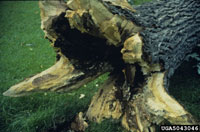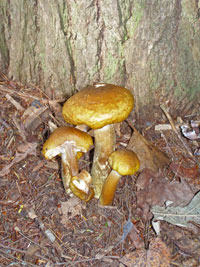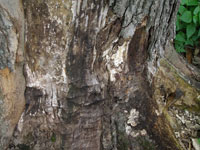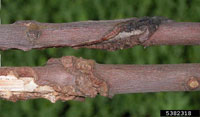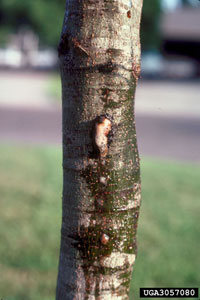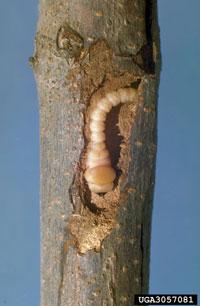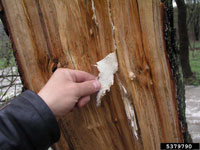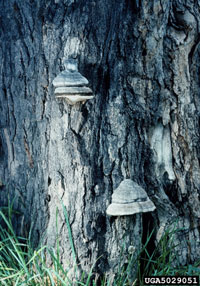Extension > Garden > Diagnose a problem > What's wrong with my plant? > Deciduous Trees > Hickory > Tree breaks or falls over
Hickory > Whole tree > Tree breaks or falls over
1 of 4
Armillaria root rot
Armillaria spp.
- Infected trees have poor growth, dead branches in the upper canopy, undersized and/or yellow leaves
- Flat white sheets of fungal growth (mycelial fans) between the bark and sapwood at the base of infected trees
- Thick black, shoestring-like fungus can sometimes be seen under the bark, around roots and in the soil around the base of the tree
- Wood is decayed, white, soft and spongy; this may extend from the base of the tree well up into the trunk
- Trees frequently break or fall over in storms
- Clusters of honey-colored mushrooms may grow at the base of the tree in fall
- More information on Armillaria root rot
2 of 4
Flathead appletree borer
Chrysobothris femorata
- White froth usually oozes from cracks in bark
- Dead branches in crown of older trees
- Bark becomes sunken at site of injury; bark may crack later
- Injured areas become larger and deform with annual attacks
- Young and stressed trees are most at risk
- Larvae are cream-colored, flattened bodies, about 1 inch long
- Long tunnels under the bark girdle trees and cause structural weakness
- More information on Flathead appletree borer
3 of 4
Heart rot
Fomes fomentarius
- Canopy may show no symptoms, or may have small, yellowing leaves or dead branches depending on the extent of decay
- In cross section, the wood at the center of the trunk is white, mottled, soft and crumbly
- Hoof-shaped, silvery-grey to brown, fungal fruiting bodies up to 8 inches across arise along the stem; often near a pruning wound, crack or other wound
- More information on Heart rot
4 of 4
Ganoderma root and butt rot
Ganoderma spp.
- Leaves are small and may yellow and drop
- Canopy appears thin with few leaves and multiple dead branches
- Fungal conks, semicircle shelf fungi, can be found from the base of the tree up to 3 feet high on the trunk
- Conks are reddish brown and shiny on top, white and porous underneath, a rim of white may be visible on the edge of the growing conks
- Infected wood at the base of the tree is white, soft, stringy or spongy
- Infected trees frequently break or fall over in storms
- More information on Ganoderma root and butt rot



